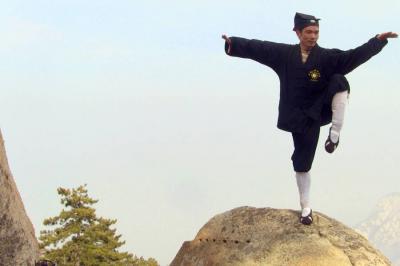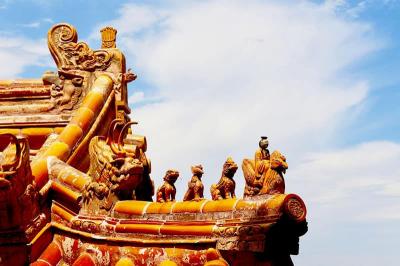Hutongs
Beijing, an ancient and vibrant city, has countless hutong streets formed in the Yuan, Ming and Qing dynasties, witnessing the changes of history and the development of the city. If you want to experience the charm of ancient Beijing and the real daily life of Beijingers, then the Chinese Hutongs are your best choice.
Fun Facts about Beijing Hutong

What is Beijing Hutong
Hutong (in Chinese: 胡同), the unique street design to Beijing, was created to reflect the imperial ruling of the emperors from within the Forbidden City. One of the explanations of Hutong has it that "Hu" is the name Han people called the other small Chinese tribes and "Tong" means "same" or "together", so Hutong means a harmony of living together between different ethnic tribes in China.
Hutongs are small lanes or alleys formed by lines of siheyuans (a traditional type of courtyard residences) with elegance and primitive simplicity, where old Beijing residents live. As time goes by, the distinctive Hutong cultural has been gradually formed. So we can say that Hutongs are witnesses of the vicissitude of the city and the development of old Beijing culture.
Moreover, the daily life of common people in Hutongs brings endless charm to the capital Beijing. And you will experience the unique Oriental culture and various interesting activities in your Beijing tour.
Origin and History
To trace the origin of Beijing hutong, we have to start it from the Yuan Dynasty. Beijing, as the capital of the Yuan, began to be built on a large scale. In order to make it easier to manage, the Yuan Dynasty government implemented a strict zoning system, dividing the city into a number of neighborhoods. Many alleys were formed in between these workshops, and these alleys were the earliest Hutongs.
The Mongols called the streets and alleys Hutongs - a Mongolian word that is said to mean wells. Could it be that every hutong in those days had a well dug (to make a miniature reservoir)? Possible. Because the nomads from the desert and grasslands valued water.
In the Ming Dynasty, there were more than 900 hutongs in the inner city and more than 300 in the outer city. The construction of Beijing city walls began to strengthen the city's defense. Beijing's urban layout gradually solidified, and the number and distribution of hutongs stabilized. Hutongs were not only residential areas, but also commercial neighborhoods where many traders set up stalls and formed a unique commercial culture.
During the Qing Dynasty, there were over 1800 hutongs in Beijing. The rulers took many measures to strengthen the security of the city. One of these measures was the establishment of “patrols” in the hutong streets, which were responsible for night patrols to ensure the safety of the residents.
During the Republican period of China, Beijing hutong lost the former prosperity. Many traders and residents began to move to other areas of the city, leaving behind many vacant houses and deserted hutongs. Some cultural celebrities, such as Lao She, began to create literary works with the hutongs as the background, so that people would pay more attention to and understand the cultural value of the hutong.
After the founding of the People's Republic of China, there were about 2550 hutongs in Beijng, but many were demolished or remodeled. Fortunately, some are preserved. They are historical cultural heritages and must-visits for anyone who visit Beijing.
>> Recommended Beijing hutong tours:
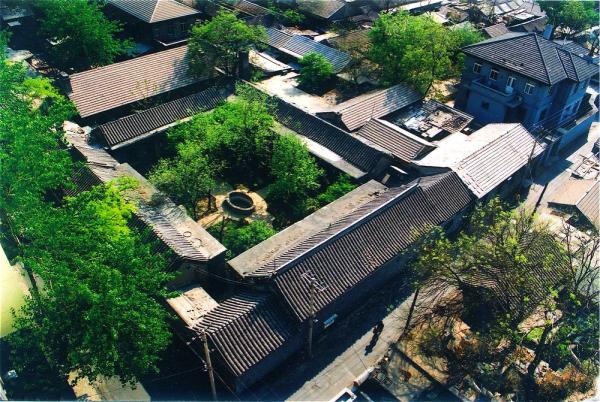
Experience Hutong Culture to Unveil the Unique Charm of Old Beijing
Quadrangle Courtyard House (Siheyuan)
The main buildings in the hutongs are quadrangle courtyards, which is a traditional Chinese dwelling where old Beijingers have lived for generations. This is a kind of closed building composed of houses on all four sides and a courtyard in the center. The quadrangle courtyard is highly enclosed, with only one gate. When the gate is closed, one can feel as if they were in a separated world, thus enjoying a strong sense of privacy. Trees and flowers are planted in the courtyard, birds and fish are raised, rocks are stacked to create landscapes, and some even have gardens.
The main house is located on the central axis of the courtyard and is usually occupied by the elderly. The east and west wing rooms are symmetrically distributed for the younger generation or guests to live in. The backroom faces the hutong alley and can be used as a study, a living room or for servants to live in.
The architectural styles and decorations of the quadrangle courtyards each have their own characteristics. They are usually constructed with wooden structures and brick walls. The beams, columns, doors, Windows, eaves and rafters are painted in various colors.
The courtyard is also an important place for neighborhood interactions, where people spend festivals and hold life events such as weddings and funerals together. Nowadays, you can still see Chinese New Year decorations and Lantern Festival lanterns hung in the courtyards.
The most famous courtyard houses are the Prince Gong Mansion and the Prince Chun Mansion.
The Names of Hutong
Their naming rules are very interesting and creative. For example, name after the shape of the Hutongs, name after the landmarks in Hutongs, name after the most commonly planted trees in Hutongs, name after the directions of the Hutongs, name after Beijing dialects, name after lucky words, name after official organizations in Hutongs, name after the local markets names in Hutongs, name after the temples in the Hutongs, name after personal names who once lived in Hutongs, etc.
>> Related reading: Travel through Hutong by Rickshaw
Beijingers’ Life in Hutong
In the hutongs and quadrangle courtyards, people can experience the rich traditional Beijing culture and gain a glimpse into the local lifestyle.
In the hutongs, you can see all kinds of small shops. There are those selling traditional Beijing snacks, those selling traditional handicrafts, as well as those repairing shoes and mending clothes. In the morning, one can always see a group of people doing square dancing, practicing Tai Chi, or waving a writing brush to practice large characters. Facilities such as a vegetable market and a park are all available.
>> Recommended China Real life tours with Beijing hutong discovery:
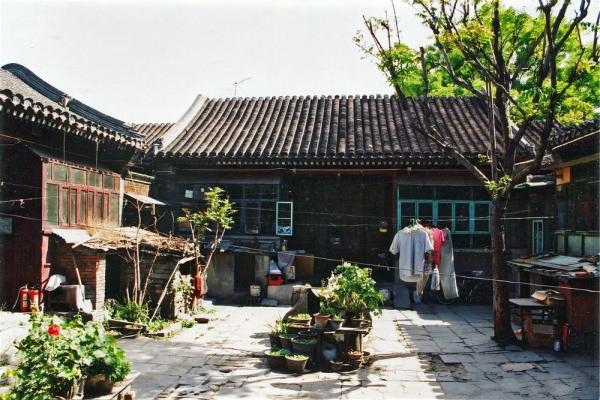
Hutong Cuisine: Taste the Authentic Beijing Food in the Neighborhood
Peking Duck: The “No. 1 Chinese Food” is made from duck, roasted over charcoal with fruitwood. The master slicer is so skillful that he slices 108 slices in 5 minutes. Rolled up in a pancake with shredded green onion, cucumber and sweet noodle sauce, the duck skin is crispy and the meat is tender.
Beijing Noodles with soybean paste: Handmade ramen noodles with diced pancetta and Roppiku yellow sauce are slowly simmered in a savory with a slight sweetness. Side dishes include shredded cucumber, radish, bean sprouts, green beans, chopped celery, shredded cabbage, and chopped parsnip.
Quick-Fried Tripe: A traditional Beijing snack made from beef tripe and sheep tripe. The tripe is shaken in boiling water for 8 seconds and dipped in a sauce made from sesame paste, fermented bean curd, chili oil, and minced garlic.
Other Beijing hutong delicacies include copper pot shabu-shabu, lo-boil, fried liver, bean juice, and hutong home cooking dishes.
Recommended restaurants: Beisanjie Hutong Noodle House, No. 69 Fried Noodle in Square Brick Factory, Dongsi Minfang Restaurant, and “Door Frame Hutong Marinated Cooking” in Qianmen Dazhalan.
>> Recommended Hutong food tours:
Top Hutongs in Beijing to Visit
There’re numerous Hutongs in Beijing. The appearances of them seem all the same, but the insides of them are distinctive. And when it comes to Beijing’s most fascinating cultural and historic relics, you should never miss the top 10 Beijing hutongs, including Nanluogu Xiang, Yandai Xiejie, Mao’er Hutong, Guozijian Street, Liulichang Cultural Street, Jinyu Hutong, Dongjiaomin Xiang or Legation Quarter,Xijiaomin Xiang,Ju’er Hutong,and The Eight Great Hutongs. Walking through the narrow alleys of quadrangle dwellings, one cannot fail to appreciate the city’s pristine, intoxicating atmosphere, and discover the old Beijingers’ lifestyle.
When to Visit
It is suitable for visiting at any time.
Recommended visiting hours: 1-3 hours
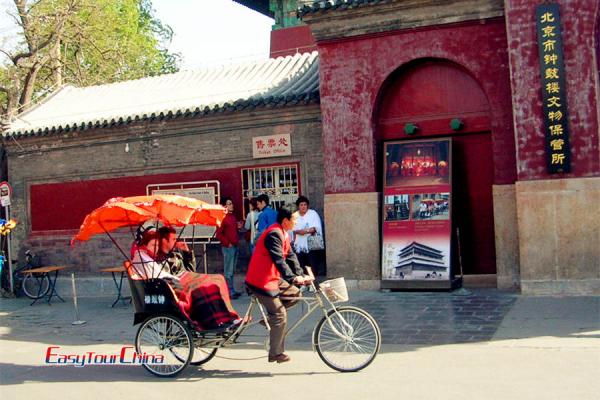
Travel Tips
1.Recommended 3 good ways to wander around the numerous crisscross hutongs: on foot, bicycle or take a rickshaw ride, and get to know more about the real Beijinger’s daily life.
2.Have a family visit in Hutongs: buy food ingredients with the host at local market, and then take a traditional Chinese cooking lesson at Hutong host family.
3.Other cultural activities can be arranged during your Hutong tour, such as learning Chinese calligraphy, making kites, playing mahjong, paper-cuttings, etc., which will let you experience a colorful Chinese cultural tour in Hutongs.
Plan Your Hutong Tour with ETC
Whether you opt to take a rickshaw hutong tour or visit the hutong in depth with cultural programs like paper-cut class, dumpling-making experience or Chinese language learning, you'll be spoilt for choice when browsing China tours including hutong experience with Easy Tour China.
See our most recommended customizable itineraries:
